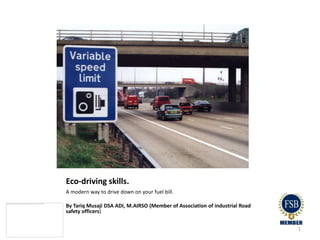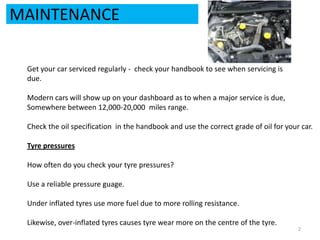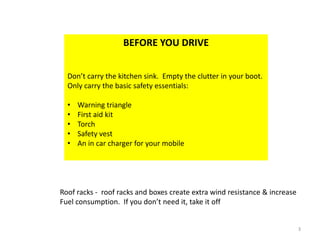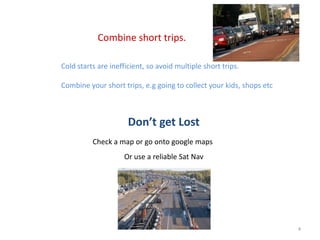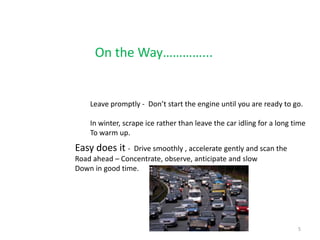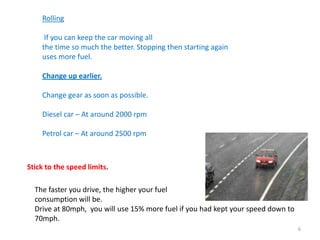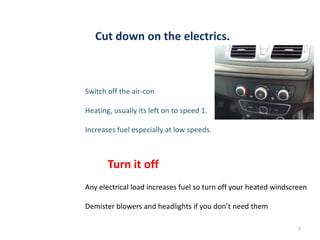Eco Driving Skills
- 1. Eco-driving skills.A modern way to drive down on your fuel bill.By Tariq Musaji DSA ADI, M.AIRSO (Member of Association of industrial Road safety officers)1
- 2. MAINTENANCEGet your car serviced regularly - check your handbook to see when servicing isdue.Modern cars will show up on your dashboard as to when a major service is due, Somewhere between 12,000-20,000 miles range.Check the oil specification in the handbook and use the correct grade of oil for your car.Tyre pressuresHow often do you check your tyre pressures?Use a reliable pressure guage.Under inflated tyres use more fuel due to more rolling resistance.Likewise, over-inflated tyres causes tyre wear more on the centre of the tyre. 2
- 3. BEFORE YOU DRIVEDonât carry the kitchen sink. Empty the clutter in your boot.Only carry the basic safety essentials:Warning triangle
- 5. Torch
- 6. Safety vest
- 7. An in car charger for your mobileRoof racks - roof racks and boxes create extra wind resistance & increaseFuel consumption. If you donât need it, take it off3
- 8. Combine short trips.Cold starts are inefficient, so avoid multiple short trips.Combine your short trips, e.g going to collect your kids, shops etcDonât get LostCheck a map or go onto google mapsOr use a reliable Sat Nav4
- 9. 5On the WayâĶâĶâĶâĶ...Leave promptly - Donât start the engine until you are ready to go.In winter, scrape ice rather than leave the car idling for a long timeTo warm up.Easy does it - Drive smoothly , accelerate gently and scan theRoad ahead â Concentrate, observe, anticipate and slow Down in good time.
- 10. 6Rolling If you can keep the car moving allthe time so much the better. Stopping then starting againuses more fuel.Change up earlier.Change gear as soon as possible.Diesel car â At around 2000 rpmPetrol car â At around 2500 rpmStick to the speed limits.The faster you drive, the higher your fuel consumption will be.Drive at 80mph, you will use 15% more fuel if you had kept your speed down to 70mph.
- 11. 7Cut down on the electrics.Switch off the air-conHeating, usually its left on to speed 1.Increases fuel especially at low speeds.Turn it offAny electrical load increases fuel so turn off your heated windscreenDemister blowers and headlights if you donât need them
- 12. 8Donât be idle.Caught in a traffic queue switch off engineWaiting for more than 5 mins?Switch it offMcDonaldâs
- 13. Heavy moving trafficTaz Musaji ADI
Editor's Notes
- #2: A presentation by Tariq Musaji DSA ADI, MAIRSO.

